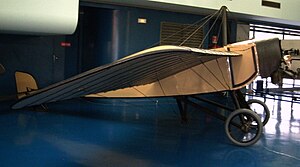Morane-Saulnier H
| Type H | |
|---|---|
 |
|
| Morane Saulnier Type H on display at the Musée de l'Air et de l'Espace at Paris Le Bourget airport | |
| Role | Sport aircraft |
| Manufacturer | Morane-Saulnier |
| First flight | 1913 |
| Developed from | Morane-Saulnier G |
| Variants | Morane-Saulnier L |
The Morane-Saulnier H was a sport aircraft produced in France in the years before the First World War, a single-seat derivative of the successful Morane-Saulnier G with a slightly reduced wingspan Like the Type G, it was a successful sporting and racing aircraft.
During the second international aero meet, held at Wiener Neustadt in June 1913, Roland Garros won the precision landing prize in a Type H. Later that same year, A Morane-Saulnier H was used to complete the first non-stop flight across the Mediterranean, from Fréjus in the south of France to Bizerte in Tunisia.
The French Army ordered a batch of 26 aircraft, and the British Royal Flying Corps also acquired a small number, these latter machines purchased from Grahame-White, who was manufacturing the type in the UK under licence. The French machines saw limited service in the opening stages of World War I, with pilots engaging in aerial combat using revolvers and carbines.
The type was also produced under licence in Germany by Pfalz Flugzeugwerke, who built it as the E.I, E.II, E.IV, E.V, and E.VI, with increasingly powerful engines. These were armed with a single, synchronised lMG 08 machine gun.
Another slightly longer German-built copy featured a steel-framed fuselage, a redesigned undercarriage integrated with the under-wing bracing pylons and a comma shaped rudder. It entered production as the Fokker M.5 and when armed in 1915 with a synchronised machine gun became first of the Fokker "Eindecker" monoplane fighters.
A Type H is preserved at the Musée de l'Air et de l'Espace in Le Bourget.
Data from flugzeuginfo.net
General characteristics
...
Wikipedia
